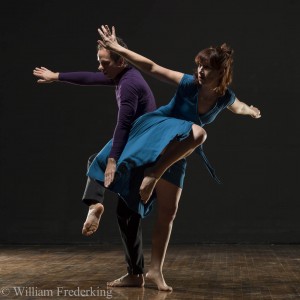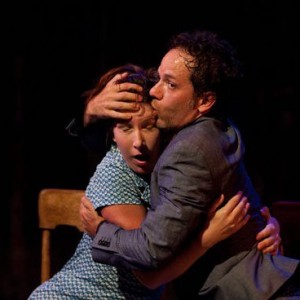by Catherine L. Tully

Mutual respect.
These are two words that form the cornerstone of any healthy long-term relationship—personal or professional. Even so, it’s often hard to check the ‘ol ego at the door for the greater good of the partnership. But take two people from the dance world that have known each other for 16 years, give them a shared vision and complementary skill sets…and wonderful things can happen.
It’s immediately obvious that there’s a deep rapport between Lucy Vurusic-Riner and Michael Estanich, and it is in every sense the foundation that their dance company is built upon. RE|Dance is a collaborative effort between these two long-time friends, and their respective titles provide all the information needed to dig a little deeper and see why they work so well together.
Vurusic-Riner is the Executive Director and handles the majority of the business aspects of RE|Dance. Estanich runs point on the creative arena as the Artistic Director. He choreographs and selects costumes. She writes grants and markets the performances.
Estanich lives in Wisconsin and teaches at University of Wisconsin/Stevens Point. Vurusic-Riner resides in Chicago and is a high school dance program instructor. They do the majority of the work for the company separately, coming together only for short spurts of time where they work together intensely, then return to their respective towns.
This makes for a challenging situation, but the two have learned to embrace it, and even thrive on it. Estanich explains saying, “Our time apart provides privacy to consider the ideas, movements, research etc., on our own (this includes the dancers too). When we are together it is RE|Dance Group nearly 24 hours a day. We are constantly together and with the company and feel a bit of pressure to generate a lot of material during those intensive rehearsals. The time apart gives me the chance to consider what the company and I have generated and see how it influences the direction of a project.”

Daily communication is important to this process, and Estanich believes this enriches the creative ideas that have been generated. “It is rare to have the opportunity to discuss the choreographic ideas so deeply before moving again,” he says, adding, “I think this builds indelible trust in each other, personally, creatively, administratively, and inspirationally.”
So how do the two artists make this arrangement work while teaching full time? They multi-task. Most projects begin with Estanich working with his students to create an initial jumping off point. Vurusic-Riner says, “We then take what they have put together, which is typically a smaller version of the piece, and we expand it to become an evening-length work.”
In the past this has meant learning from video, but for their upcoming project, The Long and Forgotten Winter, the pair used a different approach. “This is an idea that Michael developed for the company specifically and we have had full investment and ownership in it since day one,” says Vurusic-Riner, who took a more direct role in the movement development this time around.
The most interesting area of crossover is the company’s rehearsal time, directed, surprisingly, by Vurusic-Riner. Since home base is Chicago, she is responsible for keeping Estanich’s vision alive in the dancers and putting them through their paces. This creates unique challenges in its execution, but again, the respect for one another provides a through-line. “We trust each other to do what’s best for the company,” says Vurusic-Riner, adding, “We don’t always like the same things and our movement preferences are not always the same, but we do have the same vision when it comes to our artistic philosophy.”
Vurusic-Riner knows Estanich’s style so well that she is often able to “guesstimate” a movement pattern or linking step if it isn’t clear. But even so, the dancers must remain flexible in terms of learning the choreography as it can change in a moment once Estanich appears back on the scene.
RE|Dance has enjoyed steady growth throughout the five years it has been in existence, but The Long And Forgotten Winter is more than just another choreographic vision coming to life. It also represents how dedication, mutual respect and love for one’s art can triumph over distance and time. It may not be the easiest way to work, but for these two artists, it is the only way they can do what they love with the other person at their side.
Even if it’s only some of the time.
_______________________________
The Long And Forgotten Winter will be at the Ruth Page Center for the Performing Arts August 1st and 2nd at 7:30 pm and August 3rd at 3 pm. Tickets are $20.
Read more about this production on Art Intercepts.
*Lucy Vurusic-Riner is a contributing writer to 4dancers.org.















